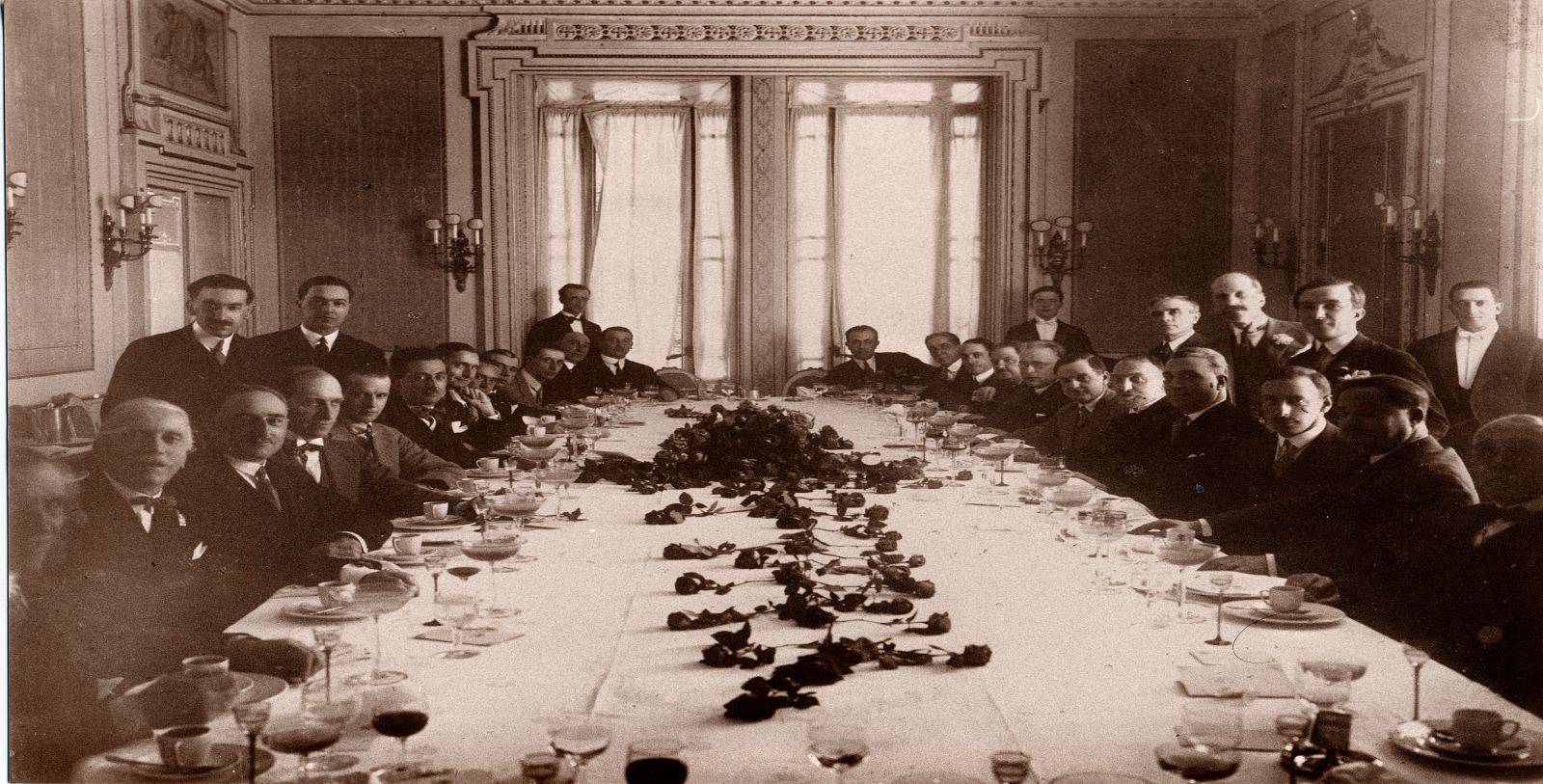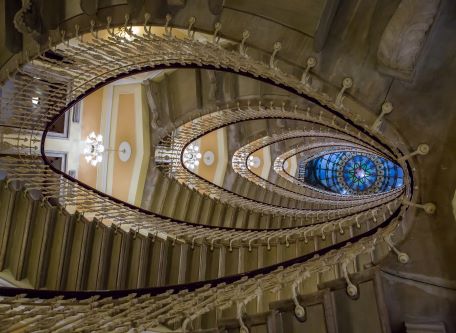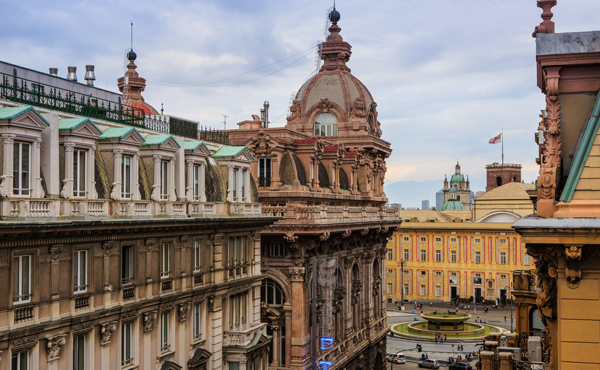Receive for Free - Discover & Explore eNewsletter monthly with advance notice of special offers, packages, and insider savings from 10% - 30% off Best Available Rates at selected hotels.
history
Discover the Hotel Bristol Palace, which was one of Alfred Hitchcock’s favorite places to stay when visiting Europe.
Hotel Bristol Palace, a member of Historic Hotels Worldwide since 2022, dates back to 1905.
VIEW TIMELINEBy the height of Europe’s Belle Époque era, Genoa had long been an incredibly affluent city. Its annual exports rivaled few other Mediterranean metropolises, save for neighboring Marseille in France. The city’s continued prosperity inspired countless entrepreneurs to develop many new businesses and cultural attractions across the community, as well. Among the greatest to debut at the time was the Hotel Bristol Palace, designed under the supervision of renowned architect Dario Carbone. Carbone proceeded to craft a stunning multistory structure along one of Genoa’s finest thoroughfares, the Via XX Settembre. The building was immaculate, mesmerizing all with its brilliant take on Art Nouveau architecture. Beautiful marble awaited guests as they stepped inside, as did outstanding woodwork and ornate moldings. Gorgeous stuccos and frescoes lined the walls, especially in the hotel’s upscale dining establishment, Giotto’s Restaurant. A gorgeous central chandelier hung down within the Sala Michaelangelo, an extravagant reading room that came complete with individual sconces and a sprawling mirror. Perhaps the most memorable feature that Carbone’s team produced was the breathtaking elliptical staircase that ascended through every floor of the hotel.
When the Hotel Bristol Palace finally opened in 1905, many in Genoa celebrated its appearance and elite level of service. Word quickly spread of its luxury, which enticed the Genoese to host dozens of exhilarating soirees and galas frequently in its meeting venues. The building’s reputation for fun and excitement eventually allured a very distinguished clientele from across the Italian Peninsula. Over the following decades, the hotel’s unparalleled hospitality gradually attracted guests from around the world. One of the most influential people to travel to the Hotel Bristol Palace was famed British filmmaker Alfred Hitchcock. His first trip occurred when he was just breaking out as a filmmaker, reserving a room at the hotel while shooting portions of his silent motion picture, The Pleasure Garden, in 1925. Impressed, he would return many other times throughout his life, with one such trip coinciding amid his filming of To Catch a Thief during the 1950s. Hotel Bristol Palace had clearly left an impact on him personally, too, for he used the building as a source of inspiration for a few of his films. Some even speculate that the grand staircase helped contribute to the theme set in his legendary movie, Vertigo.
This fantastic historic hotel has since maintained its status as one of Genoa’s most celebrated holiday destinations. The Italian Ministry of Heritage and Culture has even designated the hotel as part of its prestigious program, “Historical Places of Italy,” which recognizes only the finest historical structures in the country. Its current owners have endeavored to ensure that its rich heritage is preserved for future generations to appreciate, too. In 2014, for instance, extensive renovations were undertaken to restore the building with help from Duetorrihotels Group. Many of the fabulous stuccos and frescoes in Giotto’s Restaurant were saved during the project, as were the spectacular wall details in the conference hall. Special attention was given to Sala Michelangelo, which the architects revitalized to resemble its authentic early-20th century appearance. In fact, the team worked hard to restore every facet of the space, from its gorgeous mirror to the luxurious chandelier that hung down from the spacious ceiling. Indeed, the future of this renowned historic hotel has never looked brighter.
-
About the Location +
Historically one of the most important ports along the Mediterranean coast, the city of Genoa has a history that harkens back millennia. Archeological evidence has suggested that Genoa first emerged sometime right before the beginning of the Bronze age, ranking it among the most historic European settlements still inhabited today. A small yet prosperous municipality, Genoa eventually became an ally of the nascent Roman Empire amid its rivalry with Carthage. Once the Carthaginian Wars had concluded in the 2nd century B.C., the city was fully integrated as an official Roman town. Genoa lost some of its economic prowess following the fall of Rome in the 5th century A.D. though, with various people like the Ostrogoths and Lombards occasionally raiding the community. The nadir of this time period occurred in the 10th century, when a Fatimid navy under the command of Ya'qub ibn Ishaq al-Tamimi nearly burnt Genoa to the ground. Undeterred, the Genoese gradually rebuilt the city and its potent maritime economy. Soon enough, Genoa had forged even stronger financial relationships with some of the region’s most powerful states, like the Byzantine Empire. Genoa’s merchant fleet also grew considerably large, emerging as one of the most powerful in Europe by the height of the Middle Ages. The enhanced commerce infused unprecedented amounts of wealth into the city, empowering a whole new class of merchant noblemen that would dominate local politics for generations. Together, they marshaled their influence to transform Genoa into a maritime republic known all over as the Genoese Republic.
The newly enriched Genoese began to utilize their affluence to fund military campaigns across the Mediterranean Sea. As such, the size of the republic enlarged considerably, taking control over huge swathes of northern Italy, as well as the island of Sardinia and Corsica. Perhaps their greatest conquest was the sizeable expedition they sent to participate in the First Crusade. When the conflict finally concluded in 1099, the Genoese had seized additional trading rights throughout the Middle East. Their contributions to the war also opened up more places in the region to settlement, too, which produced dozens of small merchant enclaves. Indeed, some of those communities went as far out as the Crimean Peninsula and the Moroccan coastline. The maritime trade spawned some of Europe’s earliest financial institutions, which turned Genoa into one of the earliest centers for banking on the continent. Nevertheless, the zenith of Genoa’s power eventually emerged during the 13th century, following heralded naval victories over the Italian city-states of Venice and Pisa. But subsequent invasions by the French and Milanese gradually reduced the influence of the Genoese Republic over the following decades. Genoa nonetheless retained its esteemed reputation for sailing, with several mariners commissioned to head numerous explorations at neighboring European courts. The most prolific among that group was Christopher Columbus, who discovered the Americas at the behest of the Spanish Empire in the late 1490s.
For a while, the Genoa functioned as something similar to a client state of Spain for much of the 16th and 17th centuries. The wealthy Genoese merchants specifically provided the Spanish with much needed financial institutions that managed the influx of gold and silver from the “New World.” The association managed to resuscitate the city’s economic standing, although it was not destined to last forever. Genoa eventually slipped back into a prolonged period of decline that culminated with its defeat at the hands of its neighbors throughout the mid-1700s. Now without all its overseas territorial possessions, the municipality remained a small independent state until its capture by Napoleon Bonaparte during the Napoleonic Wars. The city briefly existed within the borders of the Ligurian Republic before it was absorbed into the Kingdom of Sardinia after the Congress of Vienna. With the unification of the entire Italian Peninsula several decades later in 1861, Genoa became a part of modern Italy for the first time. The Genoese experienced a renaissance in the wake of the event, emerging again as a dominant maritime center in the Mediterranean. Many of the city’s residents established prominent shipping companies that eventually made Genoa one of the western Mediterranean’s busiest ports. Genoa has since maintained its status as an important economic hub. It has also developed into a popular tourist destination, especially among cultural heritage travelers who have bene fascinated by its two remarkable UNESCO World Heritage Sites—the Strade Nuove and the Palazzi dei Rolli.
-
About the Architecture +
Constructed in the early 20th century, Hotel Bristol Palace displays some of the finest Art Nouveau architecture in all Genoa. Part of the greater cultural phenomenon known as the “Belle Époque,” Art Nouveau architecture was among the most popular styles in Europe from the 1890s till the outbreak of World War I. It quickly appeared all across the continent, referred to by such names like “Glasgow Style,” “Modern Style,” and “Sezessionsstil.” Some of Europe’s most prominent architectural minds employed Art Nouveau architecture, with perhaps the most noteworthy example being Hector Guimard’s wonderful Castel Béranger. The term itself was derived from an article published in the L’Art Moderne to introduce the work of architectural collective Les Vingt toward the end of the 19th century. Architects who embraced the Art Nouveau were among a growing demographic of intellectuals that yearned to create novel artistic forms that broke with the imitative historicism of the past.
More importantly, they wanted their new architectural motifs to reflect imaginative creativity, especially as European society became increasingly industrialized. Over time, those professionals created a design aesthetic characterized by its curvaceous lines and use of organic shapes. Objects from nature were featured prominently throughout the façade of every structure, too, including the likes of insects and exotic plants. Surfaces often contained terra cotta coverings, and ornate tile moldings spread throughout the interior. Sloped arches also defined the windows and doors, while fantastic mosaics existed on nearly every ceiling. Asymmetrical layouts structured many Art Nouveau buildings as well, providing for a unique appearance in many of Europe’s sprawling cities.
But other elements of the Hotel Bristol Palace showcase Art Deco design motifts, which overtook Art Nouveau as Europe’s most popular architectural form architecture during the 1920s. Art Deco architecture itself is among the most famous architectural styles in the world. The form originally emerged from a desire from architects to break with past precedents to find architectural inspiration from historical examples. Instead, professionals within the field aspired to forge their own design principles. More importantly, they hoped that their ideas would better reflect the technological advances of the modern age. As such, historians today often consider Art Deco to be a part of the much wider proliferation of cultural “Modernism” that first appeared following World War I. Art Deco as a style first became popular specifically in 1922, when Finnish architect Eliel Saarinen submitted the first blueprints to feature the form for contest to develop the headquarters of the Chicago Tribune.
While his concepts did not win over the judges, they were widely publicized, nonetheless. Architects in both North America and Europe soon raced to copy his format in their own unique ways, giving birth to the modern Art Deco movement. The international embrace of Art Deco had risen so quickly that it was the central theme of the renowned Exposition des Art Decoratifs in Paris a few years later. Architects the world over fell in love with Art Deco’s sleek, linear appearance defined by a series of sharp setbacks. They also adored its geometric decorations that featured motifs like chevrons and zigzags. But in spite of the deep admiration people felt toward Art Deco, interest in the style gradually dissipated throughout the mid-20th century. Many examples of Art Deco architecture survive today though, with some of the best located in such places as New York City, London, Paris, and of course, Genoa.
-
Famous Historic Guests +
Alfred Hitchcock, director known for such movies like Vertigo, Psycho, and North by Northwest.
Edmondo De Amicis, author best remembered for his renowned children’s novel, Cuore.
Vittorio de Sica, director known for such films as Il giardino dei Finzi Contini and Yesterday, Today and Tomorrow.
Alberto Sordi, actor known for his roles in movies like The Great War, The Best of Enemies, and I vitelloni.
Rita Levi-Montalcini, Nobel Prize-winning neurobiologist known for her discovery of the nerve growth factor.
Carla Fracci, ballet dancer regarded as one of the best to ever take the stage in the 20th century.
Rudolf Nureyev, ballet dancer known for his work with The Royal Ballett and the Paris Opera Ballet.
Yitzhak Rabin, Prime Minister of Israel (1992 – 1995)
Simon Peres, Prime Minister of Israel (1995 – 1996) and President of Israel (2007 – 2014)
Carlo Azeglio Ciampi, Prime Minister of Italy (1993 – 1994) and President of Italy (1999 – 2006)
Emperor Hirohito of Japan (1926 – 1989)



























